FIRE - Chaga truly a great tinder fungus
Mark Hordon
The Chaga Fungus (Inonotus obliquus)
In this article, we will look at the Chaga Fungus, Inonotus obliquus, which is truly one of the best forms of natural tinder for fire lighting around, and is reputed to have some remarkable anti-cancer, tonic and other medicinal effects. We will also look at where and how Chaga grows, where it can be harvested, what it looks like, how it is used, and for what, how it is prepared for both fire making and as a tea substitute and as a medicine, as well as the different qualities and grades that Chaga can be found in.
Where Chaga is Found
Chaga (Inonotus obliquus) is often referred to as the ‘Birch Conk’ or ‘Clinker Polypore’ and mainly grows on Birch trees, however, it has been reported to be found growing on Elm, Hornbeam, Beech and Alder, although this would seem to be a very rare occurrence. The Chaga conk, which often growing to the size of a football, is normally found in the more cooler climates of the Northern hemisphere, where Birch trees and forests are abundant, such as in the Russia, Northern areas of Europe, Scotland, Scandinavia, Canada and certain mountainous areas of North America.
What Chaga Looks Like

This is newly harvested Chaga conk, about the size of a child's small football. Notice the texture of the black useless outer skin that still has signs of the trees original white bark.

Photo shows an alternate view of the Chaga conk, showing more of the valued brown fungus.
The fruiting body of the Inonotus obliquus fungus, or ‘Chaga Conk’, is an irregular parasitical growth that seems to burst out from the trunk and branches of the Birch tree like an ugly black canker, erupting in very slow motion. When dry, it has a black, deeply cracked and crusty outer skin that is dense and extremely hard and crumbly; when wet the black outer skin feels like stale homemade brown bread that has become wet, slightly crumbly with just a hint of sliminess. Just below the black external skin, the interior colouration often ranges from a rich dark brown through to a yellowy, smoky, chamois leather tan as it moves deeper into the interior of the conk often with creamy white flecks. The texture seems to vary from hard to soft as it also moves deeper into the interior of the conk, there being some apparent correlation with the colour and texture.
When seen under a microscope, the Mycelium of the Chaga fungus is seen to be made from millions if incredibly minute hairs. So that when a human hair is contrasted with the fungus Mycelium, the human hair will seem to be as a massive 500-year-old tree trunk compared to a twig. Therefore, when considering just how much more easily a twig will burn, when lit with a match, compared to an uncut 500-year-old tree trunk; the tiny Mycelium hairs should easily catch and hold a comparatively massive spark, even from the relatively cool sparks created by ‘Pyrite & Flint’.
Heart Rot
Inonotus obliquus is part of the Hymenochaetaceae family of fungi that prefer to infest conifers, like Cedar, Pine, Spruce and Yew and deciduous trees like Oak, Elm and of course Birch, causing a disease called ‘Heart Rot’. The Heart Rot disease eats away at the trees wooden core, slowly ingesting it over a period of months or years, depending on environmental factors and the initial age and health of the tree when it becomes infected. As the fungus eats, and decays, the heartwood of tree, it softens the wood, eventually causing the tree to structurally weaken and ‘trunk fracture’ in high winds. The fungal infection eventually kills the tree by rotting it from the inside out.
As part of the dynamic natural cycle of life, dead, dying and decaying trees provide shelter for microbes, insects and other small animals as well as allowing room for new growth and bio diversity. If taken from Natures point of view, it is most welcome natural occurrence that creates life from death, but from a human, financial, point of view it can be quite disastrous.
The fungal spores of the Heart Rot fungi often enter the tree via a wound that breaks through the protective outer bark to the bear wood beneath. Dead branches, insect and animal damage or even fire damage, often cause these wounds. Once a Chaga conk is seen breaking the surface of the trees bark, it usually signifies that the tree is fully infected with the Inonotus obliquus fungi, and on its way out!
Spotting and Harvesting Chaga
Chaga is usually easier to spot during the winter months, since there are no leaves on the Birch trees for it hide behind, not that this is an active process on behalf of the Chaga conk, it is just that it is not always growing at a convenient height for the would be harvester to see and gather.
As the Chaga conk grows, it begins to stick out from the side tree, sometimes looking like a phallus, and when it has been snowing, it the growth can look like it is wearing a little snow-hat, which makes it stand out a little more from the tree.
It is advisable to leave smaller conks, the size of your fist and smaller on the tree, as they will invariably become much bigger over the next few years. However, if patients are not your thing and you have been taken by the excitement of the moment, a conk can be removed from the tree with an axe, knife, hatchet or saw.
Preserving Your Chaga
It is always best to dry out the Chaga conk if it is to be kept, since it will become infected with another mould if stored damp or wet … as the poem says;
‘Big fleas have little fleas on their backs to bit them, and little fleas have smaller fleas and so at infiniteum!
To dry out a Chaga conk, it is recommended that it be left in a dry shed for a month or so, or if you are as impatient as I am, it can be dried out in a very low temperature oven that does not get above a temperature of about 35 to 45°C (110 to 125°F). Leaving the Chaga in the oven for between 12 and 24 hours should dry it out nicely.
I would strongly advise that you remove the useless black outer skin surface before you begin the drying process. When the outer black skin is still damp, or wet, its removal is that much easier. If the Chaga conk has already dried out, it is a good idea to place it in a bucket of warm to hot water for a while, as this will quickly soften the outer skin, facilitating the progress of in its removal.
Uses for Inonotus Obliquus
The Birch tree has to be one of the most useful trees for Survival and Bushcraft enthusiasts there is. It can be tapped for its sap during the early spring; the bark can be made into canoes, baskets and other useful containers and can be heat processed to produce Birch Bark Tar, which is used along with other things as a preservative for outdoor wooden items. The bark is also incredibly useful for use in fire making, as it will burn even when wet, also if the bark is finely shaved with a sharp knife, it can easily be ignited directly into a flame, from the sparks produced from a modern ferrocerium rod. The wood from this wonderful tree is easily carved into beautiful and useful utilitarian tools, like spoons, bowls and knife handles. In addition, although is bad for Birch trees, when they have become infected with the Inonotus obliquus fungus, they produce Chaga conks that are one of the best forms of natural fire lighting tinder there is, a real must have for Survival and Bushcraft enthusiast everywhere. To add further to its long list of useful attributes, the Chaga fungus is said to have near magical medical properties in the fight against cancer, and make a wonderfully refreshing cup of tea!
Inonotus obliquus for Fire Making
For the purposes of fire making, the Inonotus obliquus fungus enhances the overall usefulness of the amazing Birch tree, by creates one of the very best forms of natural tinder around – Chaga. The Chaga fungus can be used as tinder without the need to process it in any way, except by removing the black outer layer and drying it out; when dry it can be used, more or less, directly from the tree. Unlike other forms of natural tinder, such as natural Amadou (Fomes fomentarius), it does not need to be boiled, steeped in water for extended periods of time, and then made pliable by rubbing, or gentle beating with a wooden mallet and it does not need to be treated with Potassium Nitrate to enhance its spark catching abilities.
When used as tinder Chaga to create an ember, however this is done, it is easily transferred to a previously prepared Tinder Bundle, where it can be blown into a flame and used to light a campfire. See some of my other articles: ‘Making a fire from sparks,’ ‘Using Amadou for fire lighting,’ ‘How to use a Ferro Rod’ and ‘Hudson Bay Tinderbox’, for more information and techniques about creating fire.
Spark Based Fire Lighting
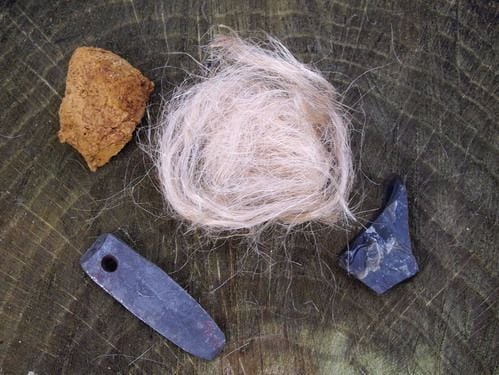
Photo 1. Photo shows in a clockwise direction: - Piece of Grade 'A' Chaga, a fluffed up piece Jute Tinder Cord, a piece of Natural Flint and the Ingot Steel Striker.
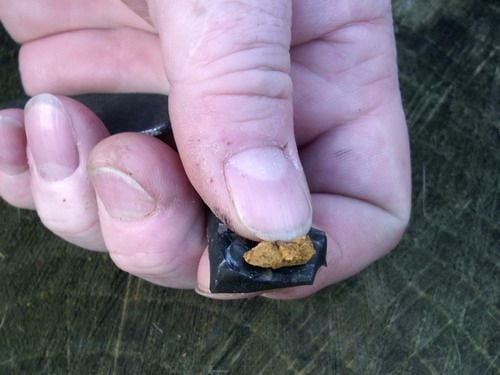
Photo 2. A small piece of the Chaga is place about 2 to 3mm from the edge of a piece of Natural Flint.
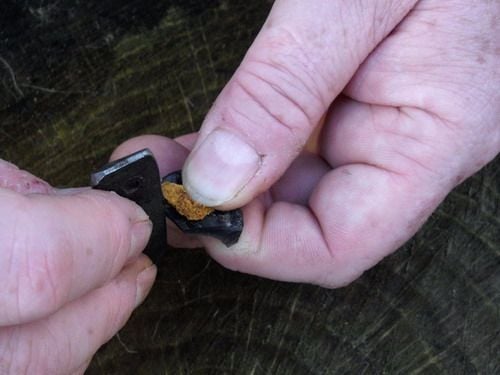
Photo 3. Squaring up the Steel Striker ready for a strike against the Natural Flint.

Photo 4. A spark has been caught by the Chaga and created an ember.
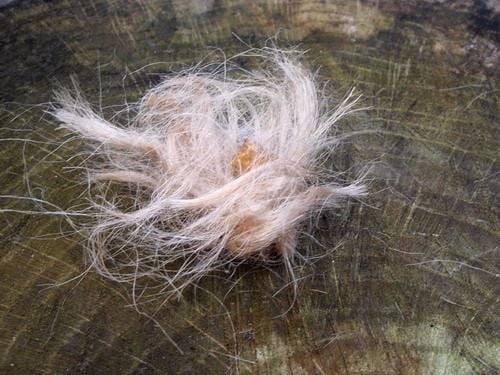
Photo 5. Place the Chaga ember into a previously fluffed up Tinder Bundle. In this case a piece of Jute Tinder Cord.
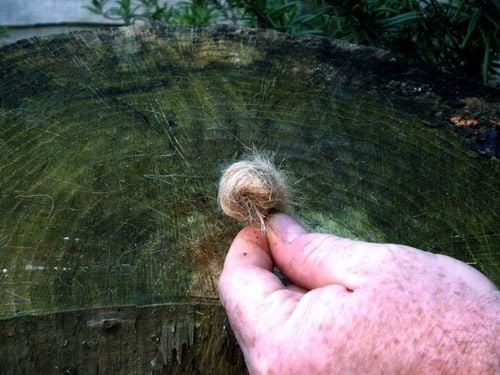
Photo 6. Carefully wrap the Chaga ember in the Tinder Bundle.
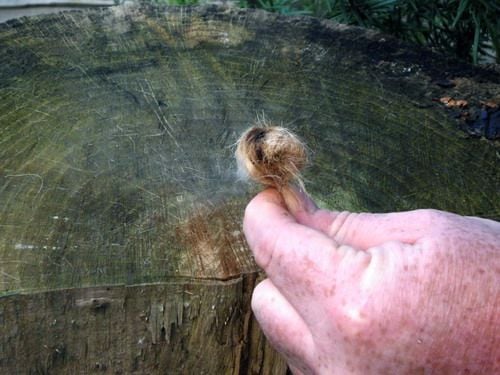
Photo 7. Gently begin to blow on the Tinder Bundle, allowing the ember to grow and heat up. As it grows, it will begin to smoke and char the Tinder Bundle.
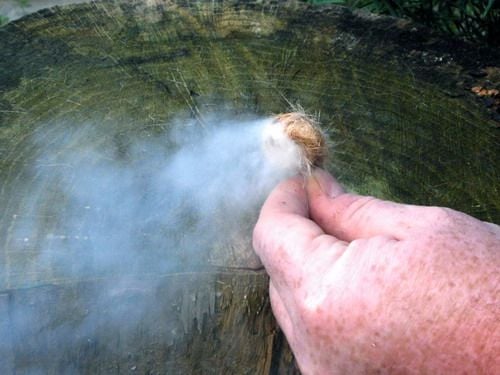
Photo 8. Keep blowing on the Tinder Bundle until a thick greenish smoke begins to appear. At this point, give the Tinder Bundle a few sharp puffs of air to allow the heat to ignite the thick smoke. The Tinder Bundle should then spontaneously ignite.
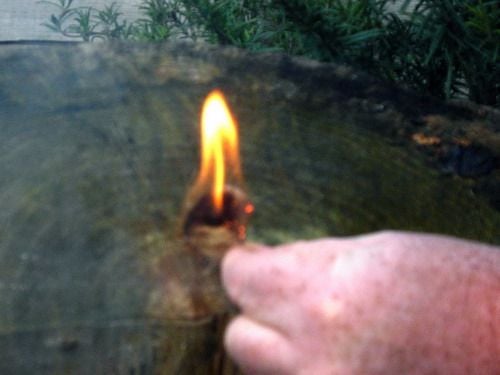
Photo 9. Eureka! We have fire. Sorry the photo is slightly blurred, blame the camera’s Auto-Focus, not the cameraman!!!
When Chaga is dry and spongy it does not need to be charred to easily catch a spark from traditional ‘Flint & Steel’ and it is almost impossible not to create an ember when using modern ferrocerium rods. Even using the sparking wheel from a dead lighter will readily create an ember when used with Chaga.
When using Chaga for fire lighting, it becomes an outstanding tinder when it has been finely powdered. In a powdered state, Chaga will easily catch a spark and hold it as an ember, even when used with super cool sparks produced from our most ancient form of spark-based fire lighting ‘Iron Pyrite & Flint’.
Compression Ignition
Chaga is one of the very best types of tinder that can be used with a Fire Piston, since it easily creates an ember. Even a very small piece of Chaga will burn for about 30 to 40 seconds, leaving ample time to transfer the ember to another piece of tinder, or winkle it out of the Piston Cup and place it in a tinder bundle ready to be blown into a flame. The very best part of the Chaga to use with the Fire Piston has a spongy feel much like cork, this part of the Chaga conk is what we call Grade ‘A’ Chaga, more on that later. The firm spongy nature of Grade ‘A’ Chaga allow it to be firmly and securely placed in the Piston Cup of the Fire Piston without fear that it will fall out when the rather violent compression phase of the process is initiated.
Solar Ignition
When Chaga is used with a Magnifying Lens or Parabolic Mirror, an ember can be created in just seconds, assuming that it is a sunny day that is!
Solar ignition is one of the easiest ways to create an ember, since it does not involve any physical exertion on the part of the user; by simply focusing the sun’s rays into a fine point smoke will almost instantly start to rise, very quickly followed by an ember. Placing the ember into a Tinder Bundle, it can quickly be blown into a flame to light a campfire.
Solar Ignition with The Hudson Bay Tinderbox's x6 Magnifying Lens
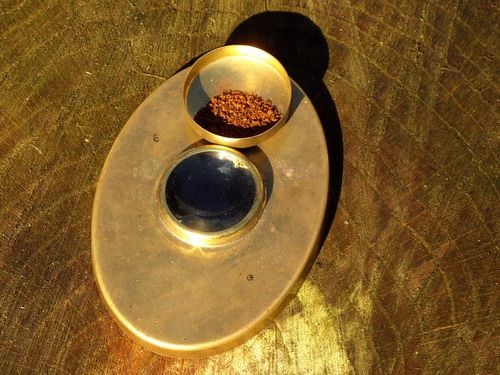
Photo 1. Photo shows some Grade ‘C’ Chaga Powder that has been placed into the Hudson Bay Tinderbox Lens Cap, ready to be ignited by the Hudson Bay Tinderbox x6 Magnifying Lens.
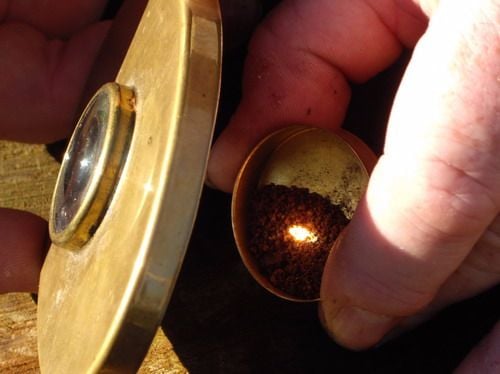
Photo 2. The sun’s rays are focused through the Hudson Bay Tinderbox’s Lens.
Photos taken mid-November, in the UK.
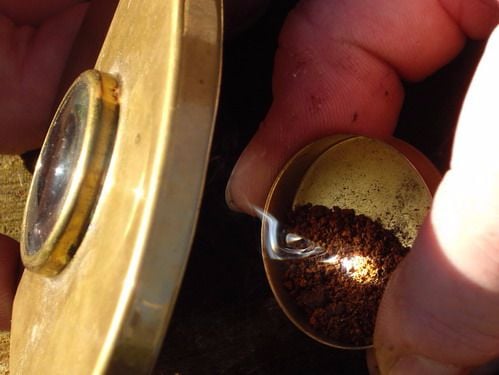
Photo 3. Almost instantly, there is a wisp of smoke rising from the powdered Chaga, indicating that an ember has formed.
Solar Ignition with the Pocket Magnifier
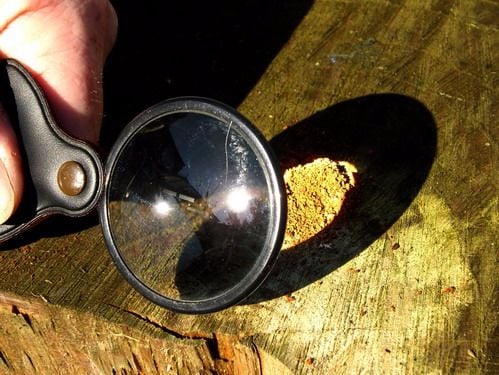
Photo 1. Finding the Focal Point of the Pocket Magnifier on a small pile of Grade ‘C’ Chaga.
Photos taken mid-November, in the UK.
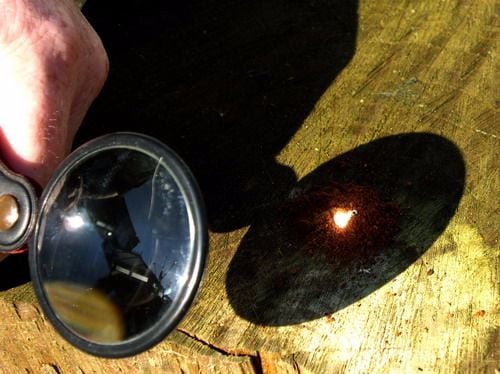
Photo 2. The Focal Point of the Pocket Magnifier is found and begins to create an ember.

Photo 3. A wisp of smoke can just be seen as the ember begins to form.
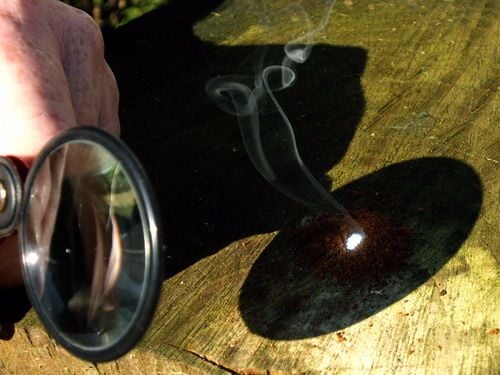
Photo 4. The presents of heavy smoking signifies that a good ember has formed and the Magnifying Lens is no longer required.
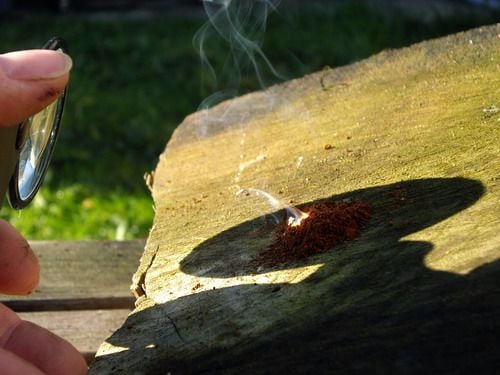
Photo 5. An alternate view of the Pocket Magnifier being used to create an ember with the Grade ‘C’ Chaga powder.
A Fire Battery
The Chaga conk can be used like a ‘Fire Battery’ or ‘Coal Extender’, enabling you to keep, store and transport an ember whenever you wish. It will happily smoulder away without fear of it going out for as long as you wish, or as long as you have Chaga to burn! A glowing ember can easily be transferred to, and from, a Chaga conk, or pieces of one, whenever you need to store fire for a few hours, and have no other means of creating an ember. When needed, the ember can then be transferred to a Tinder Bundle and then blown into flame ready to light your campfire.
Friction Based Fire Lighting
When the Chaga conk is sliced into sections of about one inch (25mm), it can be used as a super effective fire board for use with the Hand and Bow Drill methods of fire lighting. The Chaga Fireboard has just the right density to resist excessive wear, yet is soft enough to easily create the hot dust that is essential for this form of fire lighting. Once an ember has been created, it is easily winkled from the main body of the Chaga Fireboard, carefully placed in a previously prepared Tinder Bundle and then blown into a flame ready for a firelay.
Other Notable Uses for Chaga
As a Tea or Coffee substitute
Surprisingly enough, Chaga makes a remarkably good cup of tea. It is mildly sweet and quite refreshing. By steeping a small amount in boiling water for five to ten minutes or so, you have the makings of a refreshing hot drink that is also said to have remarkable medicinal properties. Adding a sweetening agent, if it is desired, such as Stevia, Honey, Sugar or your favourite sweetener can enhance the flavour even further.
Chaga as a Medicine
Chaga as an Anti-Cancer, Anti-Viral and Free Radical Treatment
It is reported that Chaga makes a remarkably effective medicine when used in the treatment cancer, since it contains a high amount of an active anti-tumour chemical called Inotodiol (The name most probably being taken from the Latin for this fungus - Inonotus obliquus). Other know, active, ingredients include Betulin and Lupeol, also found in Birch and other kinds of tree bark, which was used by Native Americans to treat such things as Insect Bites, Skin Irritations, Tumours, Lymphatic disorders and TB.
Chaga is also known to contain various Polysaccharides – long chain molecules such as Starches and Glycogen - and a large amount of Antioxidants such as vitamin ‘C’, which rid the body of Free Radicals. Chaga has also been shown to have antiviral properties that are used in the fight against HIV as well as in the treatment of chronic inflammation of stomach, stomach ulcers, and diseases of Duodenum, Liver and Spleen. Please Note: We make no medicinal claims about this product.
For use as a medicine, Chaga is usually made and then imbibe as either a tea or a tincture, it being consumed on a daily basis. Strangely enough, evidence suggests that only Chaga that grows on the Birch tree has the potent anti-cancer properties.
Preparation - Decoction
For use as a medicine, the Chaga is best dried, then ground like a coffee bean in a coffee mill, or even in a liquidiser. Once ground, it is recommended that the best medicinal properties be extracted by decoction, which is when the medicine is boiled in water for an hour or so. The use of a Chinese ceramic double boiler, which is like a large pot with a two lids, one inside the other, that is placed in a pan of boiling water, much like a bain-marie, is ideal for this purpose. All of the volatile elements are sealed within the pot and cannot escape; also, it is a much more gentle way of decocting the ingredients than with direct heat. Once decocted in this way, it is then drunk on a daily basis like a tea. Chaga tea, made in this way, will be darker in colour and have a stronger taste than if it were made by simply steeping in water for 5 to 10 minutes, since more of the essential – medicinal -chemicals will have been extracted.
Preparation – Tincture
When Chaga is required as a tincture, it is best extracted in Vodka. Vodka is a pure diluted alcohol with no added flavours or other characteristic chemicals that will compromise or interfere with the chemicals extracted from the Chaga as it is being made. Take a bottle of Vodka and pouring most of the contents out into a clean jug, the bottle can then be half filled with the powdered Chaga. Once half filled with the powdered Chaga, pour the Vodka back into the bottle until full. Leave for a couple of minutes to let the Chaga absorb the Vodka and then refill the bottle as needed. Replace the cap and give it a good shake. If need be you can add some more of the Vodka as a top up. Keep the remaining Vodka in another bottle to be used later. Allow the brew it steep for a few days or even a week, or so, would be better. The longer the better is the general rule of thumb when it comes to steeping in alcohol. I have some ‘Chinese Strike Wine’, or ‘Dit Da Jow’ – used in the Martial Arts as a treatment for sprains and bruises– that I have been steeping in this way for around twenty years, and although you might think that this a little excessive, it is believed that it only gets better with age, much like a good Whisky! For use as a medicine, however, I am in no way suggesting that you need wait this long, as I have already said, steeping for a few days or a week, or so, will do adequately.
Once the Chaga powder has been steeping for a while and the Vodka has turned a nice tea colour, it is time to decant it from the Chaga sediment into a clean jug. Once decanted you should pour the remaining, unused, Vodka that was initially left over, onto the Chaga powder dregs, replace the cap and give it a good shake. Once again, this should be steeped for a good few days or even weeks. The decanted Chaga tincture can be poured into the other bottle and labelled. After the Chaga has been steeped for the second time, decant the Vodka and pour into the first decanted Chaga Tincture. The Chaga dregs will pretty much be depleted of all the active ingredients, so they can be thrown away. The two batches of decanted Chaga tincture, combined into one, is now ready to be used. This method of extraction is known as the ‘Double Extraction Method’.
Chaga as a Tonic Drink
Chaga has been used in Russia for hundreds of years, under the name of ‘Befungin’, as a Tonic for the Stomach and Bowels and is used for certain skin problems such as psoriasis and eczema. It does seem to be a wonder drug that is much undervalued in Western medicine.
Chaga as a Replacement for Hops in Beer
One of the more unusual uses I have come across for Chaga, although I don’t see why I should see it as unusual, since upon reflection, it make perfect sense to use in this way, is in brewing beer. It is said to make a good substitute for Hops. Apparently, it is quite pleasant, but never having tried it for myself, I cannot comment further.
Chaga as a Dye
Chaga has been used for centuries as a dye for textiles; it has a yellowy smoky tan colour, but this is dependent on the mordant that is being used to fix the colour to the fabric.
Chaga as Incense
When it is burned, Chaga has a pleasant woody fragrance, with just a hint of the exotic. On the whole, however, it has quite a neutral smell, so whilst it can be used to make a fairly pleasant incense, bearing in mind the heavy cost of this fungus, it is, in my opinion, a fragrance that is best enjoyed when used in the fire making process.
Not all Chaga is the same!
We stock a large selection of authentic Chaga tinder in several grades of quality ranging from:-
Grade ‘A’ Chaga
Grade ‘A’ Chaga is the very best grade that we supply specifically for fire making. It has a very light and spongy texture, resembling cork, and has a distinctive hollow, sound when gently rubbed with a finger.
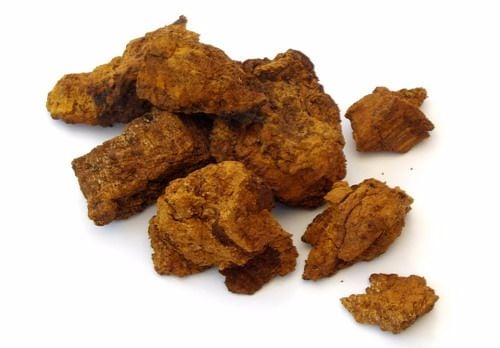
Grade ‘A’ Chaga has a light corky texture that easily catches a spark.

Grade ‘A’ Chaga shown with a newly harvested Chaga conk.
It is the very best form of Chaga, when it comes to spark based fire lighting that we supply, since it will readily catch a spark, and then hold it as a stable ember for a considerable length of time. A small piece, just the size of your little fingernail, will readily smoulder away for about a minute and a half and then continue to glow as a red-hot ember for a further minute or two.
Unfortunately, for the pyromaniacs amongst us, only about 10 to 15% of the Inonotus obliquus fungus conk is Grade ‘A’ Chaga. The remaining is mostly Grade ‘B/C’ or lower, including the useless black outer skin layer.
Grade ‘B’ Chaga (Chaga)
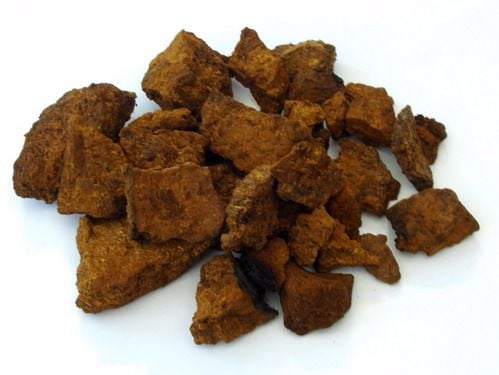
Grade ‘B’ Chaga (Chaga) is denser in texture than Grade ‘A’ Chaga and is usually darker in colour, however, it still easily catches a spark.
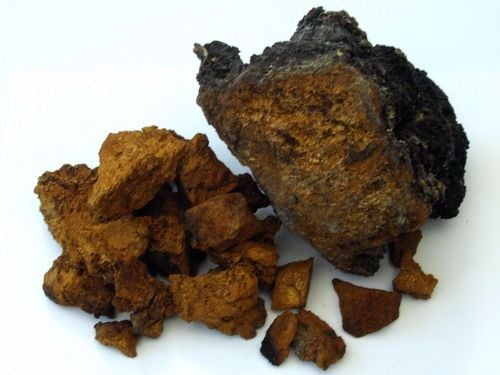
Grade ‘B’ Chaga (Chaga) shown with a newly harvested Chaga conk.
By far the largest portion of the Chaga conk consists of Grade ‘B’ Chaga, at around 65 to 75%. The remaining 10 to 25% being made up of Chaga that does not take a spark or burn at all well as well as the useless black outer skin.
Our Grade ‘B’ Chaga, referred to as simply 'Chaga' since the majority of the Chaga Conk consists of it, is still fantastic for all forms of fire making, however, it has a much harder and denser texture than does our Grade ’A’ Chaga, and when gently rubbed by the finger it sounds much harder and much more solid.
Chaga still reliably catches a spark from traditional ‘Flint & Steel’, but requires a slightly better technique than would be needed when using the Grade ’A’ Chaga. It will readily ignite with a magnifying lens, on a cold sunny winter’s day, and is great when used with Fire Pistons.
Overall, Chaga is an extremely valuable form of tinder, and favoured as such by pyromaniac aficionados.
Chaga is a naturally produced product. The sizes, thickness, weight and density, of each piece, will vary from piece to piece. As with all forms of Chaga, however, a little goes a long, long way.
Grade ‘C’ Chaga - Powdered
Do not be deceived by the term Grade ‘C’ Chaga, all that this means is that we have taken the Grade ‘B’ Chaga and ground it to a powder. Taking the Grade ‘B’ Chaga and grinding it to a powder increases its overall effectiveness when used in spark-based fire making techniques, especially with the ancient ‘Pyrite & Flint’ method, which can sometimes be a little difficult to master, since the sparks are so cool.
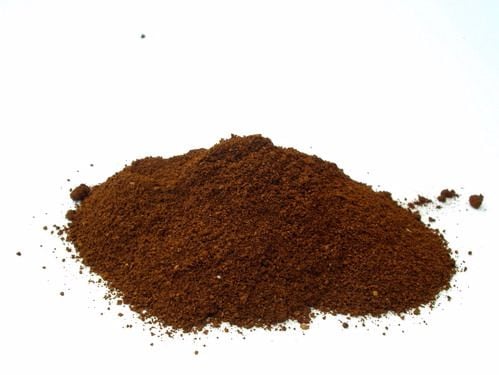
Grade ‘C’ Chaga is simply Grade ‘B’ Chaga that has been powdered. In a powdered state, it has the same fire lighting potential as Grade ‘A’ Chaga, and easily takes a spark from ‘Pyrite & Flint’.
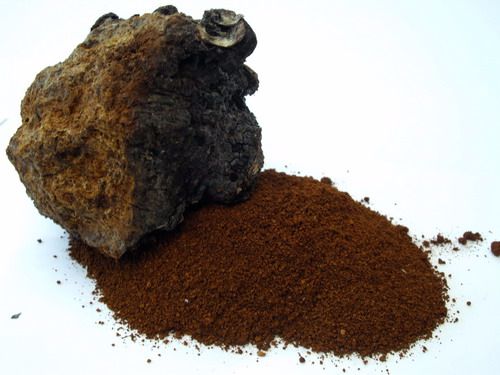
Grade ‘C’ Chaga shown with a newly harvested Chaga conk.
In a powdered state, Chaga is incredibly effective when used with a Magnifying Lens on sunny days. The sun’s rays being focused on a small pinch of the powder placed in a tinder bundle, will, more or less, instantly begin to smoke and create and then create an ember, which can then be blown in to a flame to light a campfire. I should point out, however, that Grade’ C’, powdered, Chaga is not is not best used with Parabolic Reflectors, unless the mirror has a ‘Focal Point Cup’ of some kind to hold the powder in, whilst it is being pointed towards the sun. Another, minor, down side to using powdered Chaga, is that it is not really suitable for use in a Fire Piston, unless the Piston is held upright on a stable platform and the main body of the piston is forced downwards instead of the other way around.
When using Grade ‘C’ Chaga, however, because it is already powdered, makes a fantastic substitute tea, super tonic, hot beverage for drinking on cold winters days, and as a refreshing tea during hot summer months. Just add one teaspoon of the powdered Chaga to a cup of boiling water and leave too steep for five minutes or so, add your favourite sweetener – sugar, honey etc. – if desired - and drink.
Fireboard Chaga
When used with friction based fire lighting techniques such as with the Hand or Bow Drill methods, it is amazingly effective, since it has just the right density to withstand the drill head without wearing away too quickly, yet develop an ember with minimum effort. The Chaga Fireboard is strong and easily carried. It is easy to scrape, with a knife, into an incredibly fine powder for use in spark-based fire lighting techniques and for use a pleasantly flavoured tea substitute.
Fireboard Chaga is not as readily available as we would like. We only ever have a very limited stock, and can only obtain it once in a while. Once our stock is gone, it is very difficult to say when we can restock it again.
Fireboard Chaga is a naturally produced product. The sizes, thickness, weight and density, of each piece, will vary from piece to piece. As with all forms of Chaga, however, a little goes a long, long way.
Remember: - Fire making skills needs to be practiced to be perfected.
Practice these skills with safety at the forefront of your mind.
